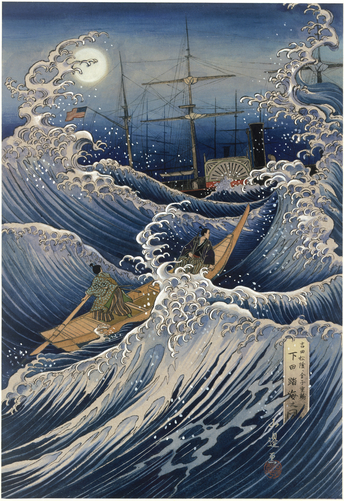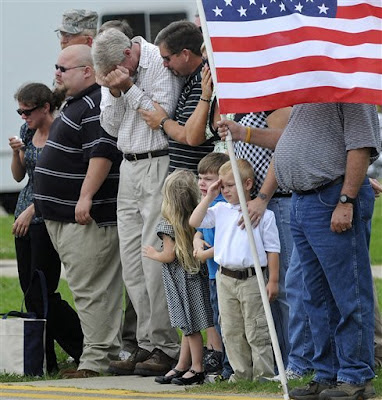Eight-year-old Christian Golczynski accepts the flag for his father,
Marine Staff Sgt. Marc Golczynski, during a memorial service. Marc
Golczynski was shot on patrol during his second tour in Iraq (which he
had volunteered for) just a few weeks before he was due to return home.
The father of Lance Cpl. Christopher Mies salutes the casket of his son
Mar. 23, 2011, at Buckley Air Force Base.
"He was just such a big part of my life. I miss him when I go to bed at night and I miss him when I wake up in the morning. I keep waiting for him to walk through the front door, even though I know he's gone." Carrie Price lost her husband Cpl. James Price in Afghanistan.
One of two US Soldier killed in Iraq. Dec. 2011
Carla Buyes has a tear wiped away by her husband, Michael, after
receiving a flag from a member of the Oregon Military Funeral Honors
Team during a Memorial Day ceremony at Restlawn Memory Gardens, in,Salem
Ore., on Monday, May 28, 2012. Buyes' son, Marine Cpl. Adam Buyes, was
killed in Afghanistan in November 2011.
Read more here: http://blogs.sacbee.com/photos/2012/05/memorial-day-2012.html#more#storylink=cpy
Pearl Harbor survivor Houston James of Dallas is overcome with emotion
as he embraces Marine Staff Sgt. Mark Graunke Jr. during the Dallas
Veterans Day Commemoration at Dallas City Hall in 2005. Sgt Graunke, who
was a member of a Marine ordnance-disposal team, lost a hand, leg, and
eye while defusing a bomb in Iraq in July of 2004.
Fiancee of a soldier killed in Iraq in February by an IED mourning him at Arlington Cemetery in May 2011.
The loyal dog of a fallen SEAL soldier lays in mourning at a casket
refusing to leave his owners side. 35 year old Navy SEAL Jon Tumilson
was one of the soldiers killed on August 6th when their Chinook
helicopter was shot down by a Taliban rocket-propelled grenade.
Mourning US soldier slain in Iraq. Feb.2012
Mother and Brother mourn fallen British soldier Ben Baington-Browne.
“His raucous laughter would fill the room, and his compassionate nature filled
our hearts with joy. "He always saw the good in people, and his sense of care and
responsibility towards his troop was endearing. “We miss him so very much.”
Jane Duffy cries as the hearse carrying the body of her son, Lance
Corporal Liam Tasker passes along High Street in Wootton Bassett,
England.
Here's a few photos from Ashley Gilbertson's "Bedrooms of the Fallen."
Thought, I would leave you with at least one happy ending...
Terri Gurrola is reunited with her daughter after serving in Iraq for 7 months. April. 2006





 According to ancient chronicles a the islands of Japan were created by the gods
separate and apart from the rest of the world, with the emperor himself a divine
descendant of the sun goddess.
According to ancient chronicles a the islands of Japan were created by the gods
separate and apart from the rest of the world, with the emperor himself a divine
descendant of the sun goddess.
 "Eastern ethics and Western science" became the slogan of scholars such as Sakuma
Shozan, who was to have great influence on Yoshida Shoin, and who saw clearly that
purity of spirit alone would not defeat Western cannon. There was a growing perception
that unless some careful modernization was undertaken, the tranquil life of the
isolated island empire would be endangered. In Yoshida's birth year, however, few
suspected that only 40 years later an epoch would be finished -that they were the
last samurai.
"Eastern ethics and Western science" became the slogan of scholars such as Sakuma
Shozan, who was to have great influence on Yoshida Shoin, and who saw clearly that
purity of spirit alone would not defeat Western cannon. There was a growing perception
that unless some careful modernization was undertaken, the tranquil life of the
isolated island empire would be endangered. In Yoshida's birth year, however, few
suspected that only 40 years later an epoch would be finished -that they were the
last samurai. For a Samurai, not only must the body be always ready, skilled in the martial arts,
but the mind must be constantly informed as well. Young warriors capped their formal
education by traveling within the country, meeting others like themselves. At 20
Yoshida went south, onfoot and by boat, to Kyushu, reading every book he could borrow
along the way.
For a Samurai, not only must the body be always ready, skilled in the martial arts,
but the mind must be constantly informed as well. Young warriors capped their formal
education by traveling within the country, meeting others like themselves. At 20
Yoshida went south, onfoot and by boat, to Kyushu, reading every book he could borrow
along the way. The major danger by now,
of course, was the barbarian. The shogunate had attempted internal reforms before
Perry appeared,including the limited encouragement of Western technology. But still
for many Japanese the ideal realm was the one they inherited from Tokugawa Ieyasu;
their idea of reform was to return to the 1600s. After Perry they suddenly saw that
was impossible.
The major danger by now,
of course, was the barbarian. The shogunate had attempted internal reforms before
Perry appeared,including the limited encouragement of Western technology. But still
for many Japanese the ideal realm was the one they inherited from Tokugawa Ieyasu;
their idea of reform was to return to the 1600s. After Perry they suddenly saw that
was impossible.




















